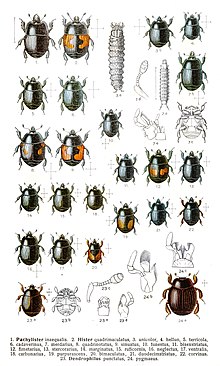Clown beetle
| Histeridae (Clown beetle) | |
|---|---|
 |
|
| Central European clown beetles with larvae and anatomical details |
|
| Scientific classification | |
| Kingdom: | Animalia |
| Phylum: | Arthropoda |
| Class: | Insecta |
| Order: | Coleoptera |
| Superfamily: | Histeroidea |
| Family: |
Histeridae Gyllenhal, 1808 |
| Genera | |
|
about 330, see text |
|
about 330, see text
Histeridae is a family of beetles commonly known as Clown beetles or Hister beetles. This very diverse group of beetles contains 3,900 species found worldwide. They can be easily identified by their shortened elytra that leaves two of the seven tergites exposed, and their elbowed antennae with clubbed ends. These predatory feeders are most active at night and will fake death if they feel threatened. This family of beetles will occupy almost any kind of niche throughout the world. Hister beetles have proved useful during forensic investigations to help in time of death estimation. Also, certain species are used in the control of livestock pests that infest dung and to control houseflies. Because they are predacious and will even eat other Hister beetles, they must be isolated when collected.
The Hister beetles are easily identified by their shiny elytra which is typically shiny black or metallic green. The two main shapes for this family are oval and flat. The elytra is shorter than the thorax with typically two of the seven tergites exposed. Hister beetles have specialized heads that can retract into their prothorax and two elbowed antennae with clubbed ends. As predatory feeders, the Hister beetles commonly feed on the Egg, larval, and adult stages of other insects. Certain species are also used to control pests that infest dung or to control house flies. Histeridae are most active at night and they will play dead if they feel threatened.
...
Wikipedia
